Krider’s Hawk (Buteo jamaicensis kriderii) stands as a distinctive and captivating subspecies within the vast realm of raptors.
Renowned for its unique plumage, this bird of prey belongs to the family Accipitridae and is a specific variation of the widespread Red-tailed Hawk (B. jamaicensis).
Recognized for its pale coloration, particularly in the head, chest, and belly, Krider’s Hawk showcases an ethereal beauty against the backdrop of diverse North American landscapes.
Its pale, often light pink or buff-colored tail further distinguishes it from other Red-tailed Hawk subspecies.
Beyond its striking appearance, Krider’s Hawk contributes to ecosystem dynamics as an opportunistic predator, displaying adaptability in its diet and nesting habits.
Understanding the nuances of this subspecies offers a glimpse into the biodiversity and underscores the importance of conservation efforts to ensure the continued presence of Krider’s Hawk in our natural habitats. Stay focused.
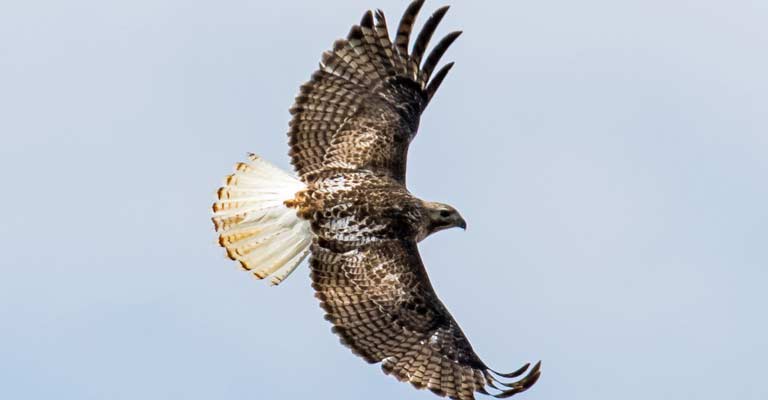
Identifying Characteristics of Krider’s Hawk
Krider’s Hawk (Buteo jamaicensis kriderii) is a distinct subspecies of the Red-tailed Hawk, known for its unique plumage and specific characteristics that set it apart from other raptors.
Identifying Krider’s Hawk requires a keen eye and an understanding of key features. Here are eight points to help in the identification process:
Plumage Coloration
One of the most distinctive features of Krider’s Hawk is its pale plumage. Unlike the typical Red-tailed Hawk, Krider’s Hawk exhibits a lighter overall coloration.
The head, chest, and belly are often a light, creamy white, with a subtle pinkish wash. This contrast in coloration makes it stand out against its darker counterparts.
Tail Characteristics
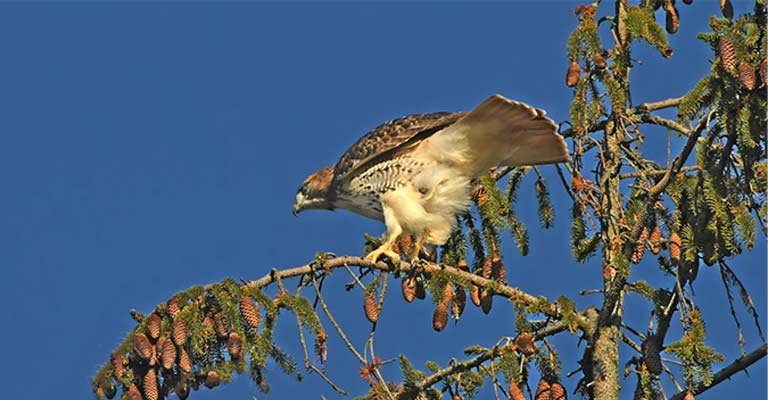
As with all Red-tailed Hawks, the tail is a crucial identifying feature. Krider’s Hawk, however, has a unique trait: a pale, often light pink or buff-colored tail.
The red tones typical of other Red-tailed Hawks are notably absent, providing a key marker for identification.
Size and Shape
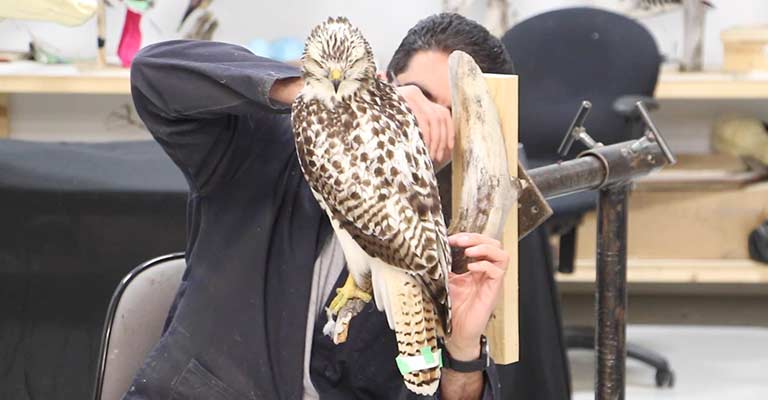
Krider’s Hawk shares the general size and shape characteristics of the Red-tailed Hawk species.
It has a robust build with broad wings and a relatively short, wide tail. The wingspan typically ranges from 45 to 56 inches, and the body length is around 18 to 26 inches.
Facial Markings
The facial markings of Krider’s Hawk are distinctive. The facial disc is pale, with a light-colored eye, giving it a gentle and almost ethereal appearance.
The lack of a dark mask around the eyes further distinguishes it from other subspecies.
Flight Pattern
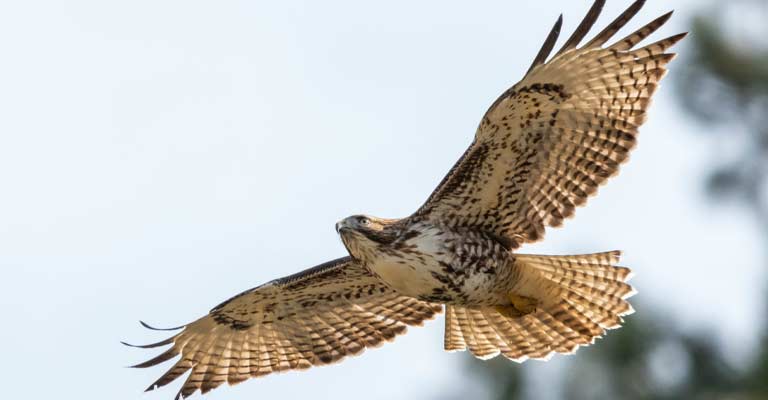
In flight, Krider’s Hawk showcases a typical soaring behavior often associated with raptors. Its broad wings and short tail contribute to a steady and majestic glide.
Observing its flight pattern can help differentiate it from other hawks in the region.
Habitat and Range
Understanding the geographic range and habitat preferences is crucial for identification.
Krider’s Hawk is often found in the central and western parts of North America, particularly in open country habitats such as grasslands, prairies, and agricultural fields.
Vocalizations
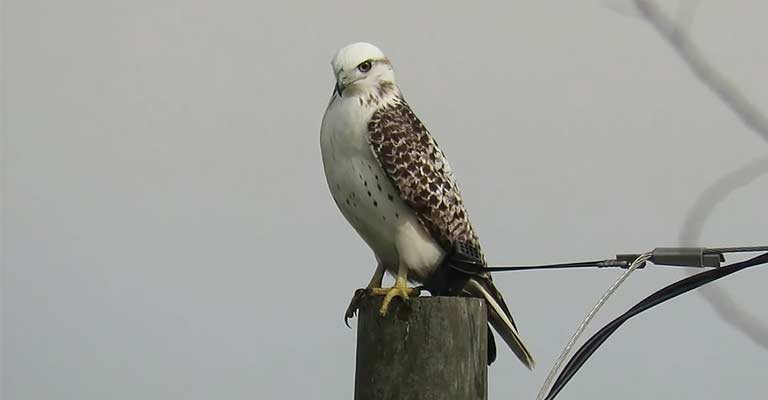
While visual cues are essential, the vocalizations of Krider’s Hawk can also aid in identification.
They produce a variety of high-pitched calls, including whistles and screams, which can be distinct from the vocalizations of other raptors in their range.
Behavioral Traits
Krider’s Hawk, like other Red-tailed Hawks, exhibits certain behavioral traits that can aid in identification.
These include perching in elevated locations, such as poles or trees, and using their keen eyesight to spot prey on the ground below.
Identifying Krider’s Hawk involves a combination of visual cues, including plumage coloration, tail characteristics, size, and facial markings, along with an understanding of their range, habitat, vocalizations, and behavioral traits.
Careful observation and familiarity with these features are essential for confidently recognizing this unique and captivating raptor in the wild.
Taxonomy of Krider’s Hawk
Here’s a table summarizing the taxonomy details of Krider’s Hawk:
| Taxonomy Level | Classification |
| Domain | Eukaryota |
| Kingdom | Animalia |
| Phylum | Chordata |
| Class | Aves |
| Order | Accipitriformes |
| Family | Accipitridae |
| Genus | Buteo |
| Species | B. jamaicensis |
| Subspecies | B. j. kriderii |
Understanding the taxonomy of Krider’s Hawk places it within the broader context of life on Earth, specifying its classification from the broad domain level down to the distinctive subspecies level.
This systematic categorization aids researchers, conservationists, and enthusiasts in accurately identifying and studying this magnificent raptor.
Krider’s Hawk (Buteo jamaicensis kriderii) belongs to the Animalia kingdom, Chordata phylum, and Aves class. It is classified under the order Accipitriformes, within the Accipitridae family.
The genus is Buteo, and the species is B. jamaicensis, with the specific subspecies designation being B. j. kriderii.
This taxonomy outlines its position as a bird of prey in the diverse avian landscape, providing a concise framework for understanding the evolutionary relationships and biological categorization of Krider’s Hawk within the broader context of the animal kingdom.
Krider’s Hawk Life History
Krider’s Hawk (Buteo jamaicensis kriderii) is a captivating subspecies of the Red-tailed Hawk, renowned for its unique plumage and intriguing life history.
This raptor, named after naturalist Harry C. Oberholser’s friend and ornithologist Henry Krider, boasts a distinctive appearance and a life history intricately woven with elements like food habits, habitat preferences, breeding behaviors, diseases, and conservation concerns.
Food
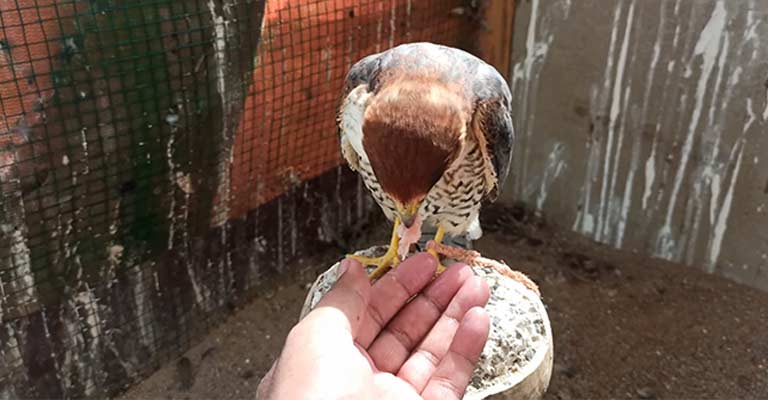
Krider’s Hawk, like other Red-tailed Hawks, is a versatile and opportunistic predator. Its diet primarily consists of small mammals, including rodents like voles, mice, and rabbits.
Additionally, they may prey on birds, reptiles, and insects, showcasing adaptability in their foraging habits.
Their keen eyesight allows them to spot prey from great heights during their characteristic soaring flights.
Habitat
Krider’s Hawk inhabits a range of open country habitats, favoring expansive grasslands, prairies, and agricultural fields. They can also be found in deserts, marshes, and along the edges of forests.
Their adaptability to diverse environments contributes to their widespread presence in central and western parts of North America.
Range Map
Krider’s Hawk has a broad distribution across North America, with its range extending from the central United States through the western regions and into parts of Canada.
A comprehensive range map showcases their presence in states such as Nebraska, the Dakotas, Kansas, and into the southern provinces of Canada, providing a visual representation of their habitat preferences.
Breeding
Breeding in Krider’s Hawks typically occurs during the spring and early summer months. They build large nests made of sticks and line them with softer materials like grass and leaves.
These nests are often situated in elevated locations such as trees, cliffs, or man-made structures.
Krider’s Hawks are known for their strong pair bonds, often mating for life. The female typically lays 2 to 3 eggs, and both parents take turns incubating them.
Diseases
While Krider’s Hawks, like other raptors, face various threats, they can be susceptible to diseases such as West Nile virus and avian influenza.
These diseases can impact their health and reproductive success. Monitoring their health and addressing disease concerns is crucial for the conservation of this subspecies.
Treatment
Veterinary care plays a vital role in the treatment of diseases in Krider’s Hawks. Prompt intervention in cases of illness or injury is essential for their rehabilitation.
Wildlife rehabilitation centers often provide medical attention, rehabilitation, and, when possible, release back into the wild.
Collaborative efforts between wildlife biologists, veterinarians, and conservation organizations contribute to the well-being of Krider’s Hawks and other raptor species.
Conservation
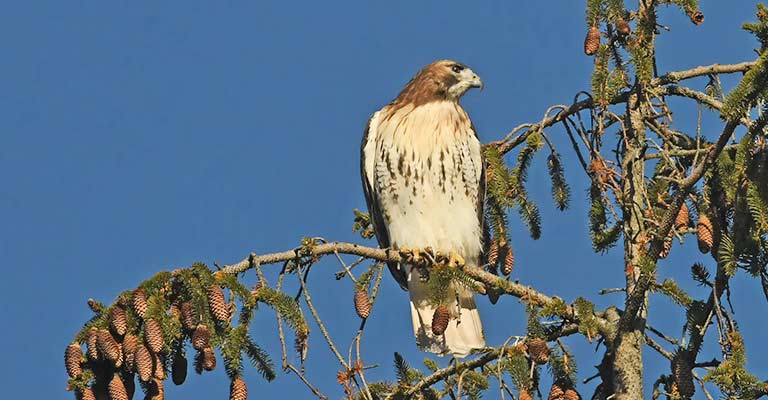
Conservation efforts for Krider’s Hawk involve preserving and restoring their natural habitats, monitoring their populations, and addressing threats such as habitat loss, pesticide exposure, and human disturbance.
Research initiatives that enhance our understanding of their ecology and behavior contribute to more effective conservation strategies.
Additionally, public awareness and education play a crucial role in fostering a commitment to the conservation of these remarkable birds of prey.
The life history of Krider’s Hawk is a captivating narrative encompassing their diverse diet, habitat preferences, breeding behaviors, health considerations, and the ongoing efforts to ensure their conservation.
Understanding and appreciating the intricacies of their existence is paramount for the continued protection and sustainability of this unique subspecies.
Nesting Habit of Krider’s Hawk
Here’s a table summarizing the nesting details of Krider’s Hawk:
| Nesting Details | Facts |
| Clutch Size | 2 to 3 eggs |
| Number of Broods | Usually one per breeding season |
| Egg Length | Approximately 2.5 to 2.8 inches (6.4 to 7.1 cm) |
| Egg Width | Approximately 1.9 to 2.2 inches (4.8 to 5.6 cm) |
| Incubation Period | Around 28 to 35 days |
| Nestling Period | Approximately 42 to 46 days |
| Egg Description | Pale bluish-white, sometimes with light brown markings |
| Nest Construction | Built with sticks, lined with softer materials like grass and leaves |
| Nest Location | Elevated sites, such as trees, cliffs, or man-made structures |
| Parental Involvement | Both parents participate in the incubation and care of nestlings |
| Mating Behavior | Strong pair bonds, often mate for life |
Understanding these nesting details provides valuable insights into the reproductive biology and behavior of Krider’s Hawk, contributing to efforts aimed at their conservation and management.
Krider’s Hawk exhibits a deliberate nesting strategy characterized by a clutch size of 2 to 3 eggs, with typically one brood per breeding season.
The eggs are pale bluish-white, occasionally marked with light brown, measuring around 2.5 to 2.8 inches in length and 1.9 to 2.2 inches in width.
Incubation, shared by both parents, spans 28 to 35 days, followed by a nestling period lasting approximately 42 to 46 days.
Nest construction involves the use of sticks, forming a substantial structure often lined with softer materials like grass and leaves.
These nests are strategically placed in elevated locations, such as trees or cliffs. The strong pair bonds and lifelong mating behavior contribute to the reproductive success and familial commitment of Krider’s Hawk.
10 Fun Facts About Krider’s Hawk
Krider’s Hawk, a distinctive subspecies of the Red-tailed Hawk, boasts a fascinating array of characteristics that make it a captivating subject for bird enthusiasts. Here are 10 fun facts about Krider’s Hawk:
- Unique Plumage: Perhaps the most striking feature of Krider’s Hawk is its pale plumage. While other Red-tailed Hawks exhibit variations of reddish-brown tones, Krider’s Hawk stands out with its creamy white and subtle pinkish hues.
- Named After a Naturalist: The subspecies was named in honor of Henry Krider, a friend of renowned ornithologist Harry C. Oberholser. This nomenclature pays tribute to the contributions of individuals passionate about bird study.
- Versatile Diet: Krider’s Hawks are opportunistic predators with a varied diet. They feed on small mammals, birds, reptiles, and even insects. This adaptability contributes to their success in diverse habitats.
- Broad Geographic Range: Krider’s Hawk is distributed across central and western North America, from the central United States into parts of Canada. This extensive range showcases their adaptability to different landscapes.
- Distinctive Tail Color: In contrast to the typical red tail of its parent species, Krider’s Hawk sports a light pink or buff-colored tail. This unique trait adds to its visual appeal and aids in identification.
- Soaring Specialists: Like other raptors, Krider’s Hawks are skilled soarers. Their broad wings and short, wide tails facilitate effortless gliding, allowing them to cover large areas in search of prey.
- Family-Oriented: Krider’s Hawks are known for strong pair bonds and familial ties. Mated pairs often stay together for life, working collaboratively in nesting, incubation, and raising their offspring.
- Elevated Nesting: These hawks prefer nesting in elevated locations such as trees, cliffs, or even man-made structures. This high vantage point provides strategic advantages for hunting and monitoring their surroundings.
- Vocal Communicators: Krider’s Hawks are not just visually striking; they are vocal communicators too. Their calls include whistles and screams, which are integral to their communication during mating rituals and territorial disputes.
- Conservation Concerns: While not currently listed as a threatened species, Krider’s Hawk faces conservation challenges due to habitat loss and human disturbance. Conservation efforts are essential to ensure the long-term survival of this unique subspecies.
Wrapping Up
Delving into the life history and nesting habits of Krider’s Hawk unveils a captivating narrative of adaptation and resilience.
From their distinct plumage to the intricacies of breeding behavior, these raptors showcase nature’s ingenious design.
Their role as opportunistic predators, coupled with unique nesting strategies, underscores their significance in maintaining ecological balance.
However, the challenges they face, from diseases to habitat loss, warrant collaborative conservation efforts.
By understanding and appreciating the nuances of their existence, we foster a commitment to safeguarding these iconic birds for future generations.
Through research, education, and habitat preservation, we can contribute to the thriving legacy of Krider’s Hawk and ensure their continued presence in our diverse landscapes. Stay focused.
